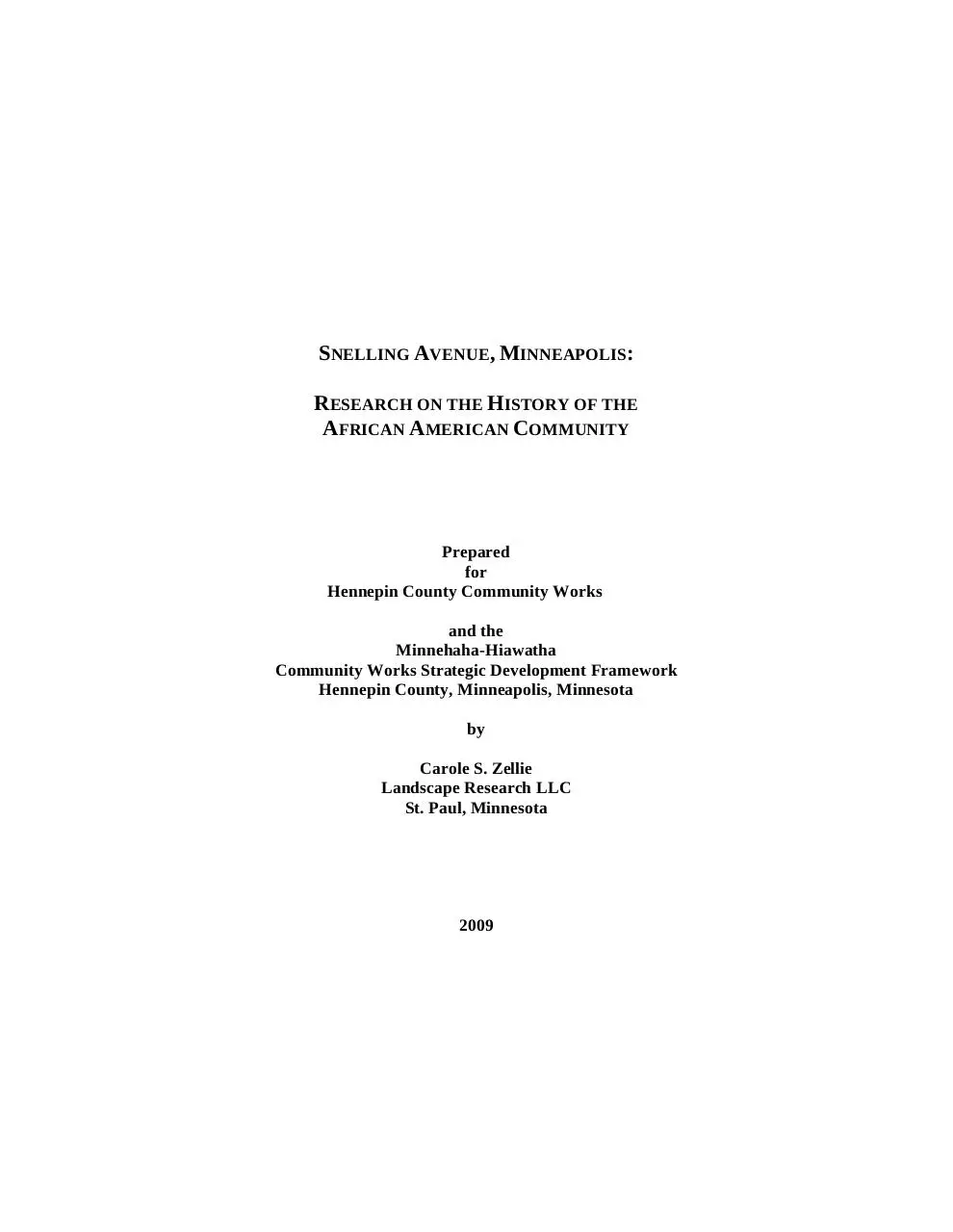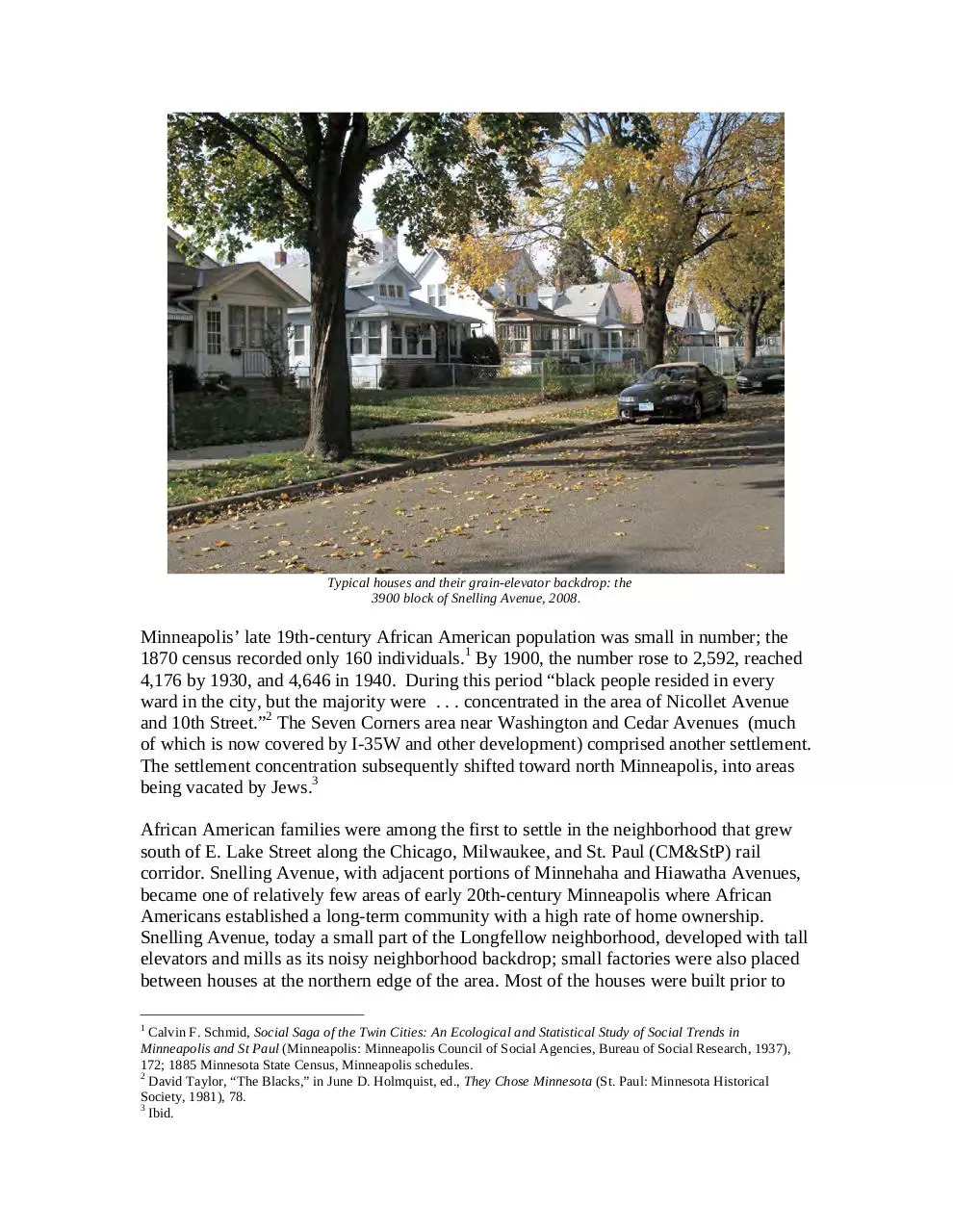Snelling Ave Final Report (PDF)
File information
Title: Snelling_Ave__FINAL030910
Author: Carole Zellie
This PDF 1.5 document has been generated by Microsoft Word / Mac OS X 10.5.8 Quartz PDFContext, and has been sent on pdf-archive.com on 03/02/2017 at 19:34, from IP address 75.168.x.x.
The current document download page has been viewed 557 times.
File size: 4.5 MB (42 pages).
Privacy: public file





File preview
SNELLING AVENUE, MINNEAPOLIS:
RESEARCH ON THE HISTORY OF THE
AFRICAN AMERICAN COMMUNITY
HENNEPIN COUNTY COMMUNITY WORKS
MINNEAPOLIS, MINNESOTA
2009
SNELLING AVENUE, MINNEAPOLIS:
RESEARCH ON THE HISTORY OF THE
AFRICAN AMERICAN COMMUNITY
Prepared
for
Hennepin County Community Works
and the
Minnehaha-Hiawatha
Community Works Strategic Development Framework
Hennepin County, Minneapolis, Minnesota
by
Carole S. Zellie
Landscape Research LLC
St. Paul, Minnesota
2009
Typical houses and their grain-elevator backdrop: the
3900 block of Snelling Avenue, 2008.
Minneapolis’ late 19th-century African American population was small in number; the
1870 census recorded only 160 individuals.1 By 1900, the number rose to 2,592, reached
4,176 by 1930, and 4,646 in 1940. During this period “black people resided in every
ward in the city, but the majority were . . . concentrated in the area of Nicollet Avenue
and 10th Street.”2 The Seven Corners area near Washington and Cedar Avenues (much
of which is now covered by I-35W and other development) comprised another settlement.
The settlement concentration subsequently shifted toward north Minneapolis, into areas
being vacated by Jews.3
African American families were among the first to settle in the neighborhood that grew
south of E. Lake Street along the Chicago, Milwaukee, and St. Paul (CM&StP) rail
corridor. Snelling Avenue, with adjacent portions of Minnehaha and Hiawatha Avenues,
became one of relatively few areas of early 20th-century Minneapolis where African
Americans established a long-term community with a high rate of home ownership.
Snelling Avenue, today a small part of the Longfellow neighborhood, developed with tall
elevators and mills as its noisy neighborhood backdrop; small factories were also placed
between houses at the northern edge of the area. Most of the houses were built prior to
1
Calvin F. Schmid, Social Saga of the Twin Cities: An Ecological and Statistical Study of Social Trends in
Minneapolis and St Paul (Minneapolis: Minneapolis Council of Social Agencies, Bureau of Social Research, 1937),
172; 1885 Minnesota State Census, Minneapolis schedules.
2
David Taylor, “The Blacks,” in June D. Holmquist, ed., They Chose Minnesota (St. Paul: Minnesota Historical
Society, 1981), 78.
3
Ibid.
Snelling Avenue History
e
1925 and industrial expansion eventually removed all but one residence from the 3000
and 3200 blocks of the avenue. Throughout its history, Snelling Avenue has also been
home to many European immigrants, including numbers of Germans, Swedes, and
Norwegians.4
African Americans were typically limited to certain types of employment, and some of
the best-paying jobs were offered by railroads. The CM&StP yards at Hiawatha Avenue
and E. Lake Street provided a variety of labor jobs, and the CM&StP and other
Minneapolis railroads also offered positions as porters, cooks, waiters, and coachmen.
The 1895 and 1905 Minnesota State Census, the 1900, 1910, 1920, and 1930 U.S.
Census, and city directories document the growth of the Snelling Avenue-area
community, which also included Minnehaha and Hiawatha Avenues and cross streets.
The 1895 census recorded three African Americans and their families living on Snelling
Avenue. J. A. McCoy, 34, a musician and native of Tennessee, was at 3015 Snelling
Avenue. His wife was a native of Germany. At 3034, William H. Howard, 28, a
coachman and musician, was a native of Maryland. His wife Emma, 26, was German. At
3036, Virgil Peebles, a 33-year-old native of New York, lived with his Swedish-born
wife and two children. He listed his employment as a clerk. By 1900 Peebles and McCoy
were living elsewhere in the city, but Howard appears to have been the pioneer who
remained and was still living on Snelling Avenue in 1930.5 By 1900, he listed his
employment as a music teacher.6 (Census-takers typically recorded residents as “Neg” for
Negro or “Mu” for mulatto, but occasionally persons previously recorded were later
classified as white. This is true of Howard, who appears as white in the 1930 census.)
William Howard owned his house, as did many other African Americans in the area.
Minneapolis building permits suggest that most appear to have purchased houses
originally built by others. In 1900, Robert Chatman, a 38-year-old native of Kentucky,
lived at 3649 Snelling Avenue. His wife, Jennie, was a native of Iowa.7 The family of
Herbert and Maggie Parker resided at 3511 Snelling by 1914. Herbert Parker was born in
Canada in 1869 to parents from Kentucky. He arrived in the United States in 1870 and
became a naturalized citizen in 1880. Maggie Parker was a native of Kentucky, and the
Parker’s two children were born in Minnesota. The family also had two lodgers who
worked as a waiter and a maid.8
In 1907, the staffing of the new Minneapolis Fire Station #24 at 4501 Hiawatha Avenue
became controversial because some white neighborhood residents did not want the
station to be comprised exclusively of black firemen. The Minneapolis fire chief to issued
a statement that the station was meant to be a “colored fire company.”9 Another argument
was made by some City Council members, who objected that it was “an affront to the
4
1900, 1910, 1920, 1930 U.S. Census, Hennepin County, Minneapolis, Ward 12.
1895 and 1905 Minnesota State Census of Population; 1900 and 1930 U.S. Census, Hennepin County, Minneapolis,
Ward 12.
6
1900 Minneapolis City Directory; 1930 U.S. Census, Hennepin County, Minneapolis, Ward 12.
7
1900 U.S. Census, Hennepin County, Minneapolis, Ward 12.
8
Minneapolis City Directory, 1914; 1920 U.S. Census, Hennepin County, Minneapolis, Ward 12.
9
“Minnehaha Residents Object,” Minneapolis Journal 13 July 1907; “Fire Chief Explains Men,” Minneapolis Journal
23 July 1907.
5
Minnehaha-Hiawatha
Community Works Strategic Development Framework
2
Snelling Avenue History
e
colored members of the force, who are credited with being first-rate men, to segregate
them in one station.” They felt that the station should be a “berth for the older members
of the force who would welcome a relief from the constant strain of downtown duty.”10 A
petition signed by 60 women, all area residents, supported the assignment of the black
firemen to the station.11
Fire Station #24 (1907), 4501 Hiawatha Avenue.
New arrivals on Snelling Avenue by 1920 included Edward Bishop, 47, a native of
Missouri who worked as a porter.12 He and his wife Katherine owned their house 3655
(57) Snelling Avenue. Sylvia Colell, 28, a widow and native of Mississippi, owned the
house at 3647. She worked as a chambermaid.13 John Monroe, 69, a native of Missouri,
owned the house at 3633. Monroe worked as a teamster and his son, Clarence Monroe,
was a fireman for the City of Minneapolis. Seymour Cornelius, a native of Kansas,
owned his house at 3847 Snelling. He was a porter in a candy store.14 In 1920 the
Cornelius household included Seymour’s wife, Laura, three children, and a niece.15 Many
households had boarders or lodgers. By 1930, Minnehaha and Hiawatha Avenues also
had African American homeowners and renters, as did a number of cross streets. Toots
Botts, an Iowa native and railroad porter, owned the house at 3724 Minnehaha Avenue.
His neighbor at 3722, James Guibert, was a dining car porter in 1920 and worked as a
janitor in 1930.16
During the period 1910-1930, railroad-related employment along Snelling Avenue was
standard for males, with job titles including “cook,” “railroad waiter,” “railroad
fireknocker,” “pullman porter,” and “railroad conductor.” Railroad workers organized
local associations such as the Colored Railroad Men’s Club, which was located at 212
10
‘Haha Objects to Colored Firemen,” Minneapolis Journal 13 July 1907, 7.
“Women Back Firemen: Petition of Sixty Stands by Colored Employees,” Minneapolis Tribune 6 Aug 1906:6.
12
1920 U.S. Census, Minneapolis, Ward 12.
13
Ibid.
14
1920 and 1930 U.S. Census, Minneapolis, Ward 12.
15
1920 U.S. Census, Hennepin County, Minneapolis, Ward 12.
16
Ibid.
11
Minnehaha-Hiawatha
Community Works Strategic Development Framework
3
Snelling Avenue History
e
11th Avenue S. in 1920.17 Cooks, clerks, hotel waiters, janitors, and porters in other
occupations were also represented, along with a few employed in industries such as
Minneapolis Moline and federal agencies such as the post office. Female occupations
included maid, cook, dressmaker, and hairdresser. Sylvestus Phelps, a native of Iowa who
moved to 3624 Snelling Avenue in 1917 and remained there until 1924, was a wellknown business owner. She owned the Phelps Cafe and Hotel at 246 4th Avenue S., and
operated the “Oh Boy ! Chicken” Shack at the Minnesota State Fair.18 Her husband,
Oliver D., was a native of Louisiana and was employed as a waiter, in furniture sales, and
in real estate.19
Mrs. Phillip McGruder, of 1828 Carpenter Ave., Des
Moines, is the guest of Mrs. O. D. Phelps, at her
beautiful residence, 3624 Snelling Avenue. Mrs.
Phelps is one of our smartest business women in the
Twin Cities and she is making preparations to
conduct a cafeteria at the State Fair during
September.
The National Advocate, July 19, 1919
The National Advocate, March 31, 1922
The modest growth of employment opportunities for African Americans in Minneapolis
coincided with the wartime economy between 1915 and 1920, when “recruiters scoured
the South for Blacks willing to move to northern industrial centers in return of promises
of free transportation, higher wages, and a better standard of living.”20 Few jobs in
private industry, however, were open to African Americans before World War II.21 For
many on Snelling Avenue, the railroad provided a level of job security. In 1930, early in
the Depression, a higher percentage of African Americans in Minneapolis were employed
than native or foreign-born whites.22 During the 1930s, however, many African
Americans were unemployed; in part this was because the domestic jobs they formerly
held were occupied by whites. During this period, restrictive housing covenants were
used to “contain and isolate Blacks.”23 Snelling Avenue and the surrounding area
provided a place where home ownership was possible.
17
Minneapolis City Directory, 1920.
Sylvestus (Sylestus) Phelps clipping file, Hennepin County Public Library Special Collections; “Sylvestus Phelps
Williams, Here 35 Years, Dies,” Minneapolis Spokesman 10 Nov. 1944:1; Minneapolis city directories.
19
1920 U.S. Census, Minneapolis, Ward 12; Minneapolis city directories 1915-1940.
20
Taylor, “The Blacks,” 81.
21
Governor’s Human Rights Commission, The Negro Worker’s Progress in Minnesota (St. Paul: 1949), 15.
22
Schmid, Social Saga, 176.
23
Taylor, “The Blacks,” 81.
18
Minnehaha-Hiawatha
Community Works Strategic Development Framework
4
Snelling Avenue History
e
In 1927, transience of the city’s African Americans was studied, and it was observed that
of 463 families in the study, 344 had lived in their present location less than five years.24
During the first 20 years of African American occupancy on Snelling Avenue (18951915), this seems to have been the case, but between 1920 and 1930, a more permanent
community appears to have developed. In 1920, for example, 8 of 14 households on the
3600 block of Snelling were owner-occupied.25 The 1930 census recorded at least 25
African American households along the length of Snelling Avenue and at least three on
adjacent Minnehaha Avenue. A total of 15 houses on Snelling Avenue were owneroccupied.26 Like the Shingle Creek area in north Minneapolis, Snelling Avenue
increasingly provided a place of permanence.27
3655 Snelling Avenue (ca. 1902), in 2009.
Snelling Avenue houses are typical of many built on Minnehaha Avenue and in the
surrounding area. Most, particularly those north of E. 40th Street, are simple one- and
two-story, gable-roofed buildings dating from before 1925. There are a number of
examples of bungalows. Many small houses, typically placed on small lots, were
enlarged and remodeled by their owners to include enclosed porches and additional
dormers. 3655 Snelling Avenue, built about 1902, is exemplary of the changes that
“wrapped” the original house. During the late 1920s and early 1930s, 3655 was the home
of James H. Johnson, his wife Vivian, and their five children. Johnson was a native of
Florida and his wife was Danish. He worked as a service man for an automobile
company.28
24
Abram Lincoln Harris, The Negro Population in Minneapolis: a Study of Race Relations (Minneapolis, Minn.:
Urban League and Phyllis Wheatley Settlement House, 1926), 15-16.
25
Review of Minneapolis building permits; 1920 U.S. Census, Minneapolis, Ward 12; Minneapolis City Directory,
1920.
26
1930 U.S. Census, Minneapolis, Ward 12; Minneapolis City Directory, 1930. Calvin Schmid’s study of the
Minneapolis population in 1930 suggested approximately 100 African Americans on the east side of Snelling Avenue
and another 30 individuals on the west side of Hiawatha. See Schmid, Social Saga, Chart 34.
27
Carole Zellie, The Shingle Creek African American Community. Prepared by Carole Zellie (Landscape Research
LLC) for Hennepin Community Works, Minneapolis, Minnesota, 2000.
28
1930 U.S. Census, Hennepin County, Minneapolis, Ward 12; Minneapolis city directories. The 1920 census
information for Johnson and his wife does not agree with that of 1930.
Minnehaha-Hiawatha
Community Works Strategic Development Framework
5
Download Snelling-Ave-Final-Report
Snelling-Ave-Final-Report.pdf (PDF, 4.5 MB)
Download PDF
Share this file on social networks
Link to this page
Permanent link
Use the permanent link to the download page to share your document on Facebook, Twitter, LinkedIn, or directly with a contact by e-Mail, Messenger, Whatsapp, Line..
Short link
Use the short link to share your document on Twitter or by text message (SMS)
HTML Code
Copy the following HTML code to share your document on a Website or Blog
QR Code to this page

This file has been shared publicly by a user of PDF Archive.
Document ID: 0000548714.